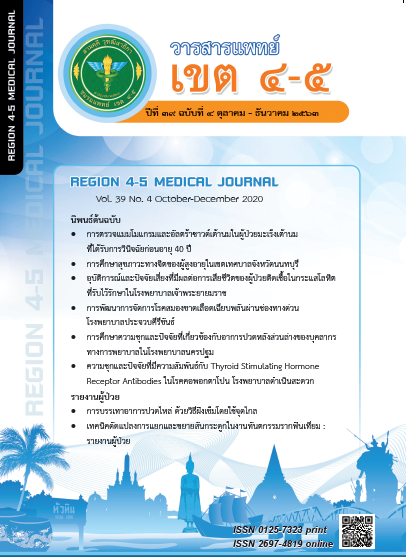อุบัติการณ์ ปัจจัยเสี่ยงและผลกระทบของภาวะไตวายเฉียบพลัน ในคนไข้หอผู้ป่วยหนักโรงพยาบาลราชบุรี
คำสำคัญ:
ไตวายเฉียบพลัน, ปัจจัยเสี่ยง, ผลกระทบบทคัดย่อ
บทคัดย่อ
วัตถุประสงค์: เพื่อศึกษาอุบัติการณ์ ,ปัจจัยเสี่ยงและผลกระทบของภาวะไตวายเฉียบพลัน ของภาวะไตวายเฉียบพลันในคนไข้ในหอผู้ป่วยหนักอายุรกรรม โรงพยาบาลราชบุรี
วิธีการศึกษา: การศึกษาวิเคราะห์แบบย้อนหลัง (retrospective study) รวบรวมข้อมูลจากเวชระเบียนผู้ป่วยในที่เข้ารับการรักษาในหอผู้ป่วยหนักอายุรกรรม โรงพยาบาลราชบุรี ตั้งแต่วันที่ 1 มกราคม 2561 ถึง 30 มิถุนายน 2561 และข้อมูลคนไข้ที่เกิดภาวะไตวายฉับพลันตามหลักเกณฑ์ KDIGO criteria พ.ศ. 2555 โดยนำมาวิเคราะห์ด้วยโปรแกรม SPSS statistics 17.0 และใช้วิธีวิเคราะห์ข้อมูลแบบถดถอยโลจิสติกหลายตัวแปร (multivariate logistic regression) สำหรับแสดงถึงปัจจัยเสี่ยงของภาวะไตวายเฉียบพลัน
ผลการศึกษา: คนไข้ที่เข้ารับการรักษาในหอผู้ป่วยหนักอายุรกรรม โรงพยาบาลราชบุรี ทั้งหมด 115 คน อุบัติการณ์ของภาวะไตวายฉับพลันคิดเป็นร้อยละ 69.6 (80 ราย) ซึ่งพบว่า คนไข้ที่มีภาวะไตวายเฉียบพลันมีการใช้เครื่องช่วยหายใจ, ภาวะ septic shock, APACHE II score, ค่าครีเอตินินที่หอผู้ป่วยหนักอายุรกรรมที่สูงกว่าคนไข้ที่ไม่มีภาวะไตวายเฉียบพลันอย่างมีนัยสำคัญทางสถิติ (p=.0001) และพบว่าปัจจัยเสี่ยงในการเกิดภาวะไตวายเฉียบพลันคือ ค่า APACHE II score ทีสูงขึ้น 1 หน่วย เพิ่มโอกาสการเกิดภาวะไตวายเฉียบพลัน 1.62 เท่า (odds ratio 1.62 ,95%CI 1.286-2.041) อย่างมีนัยสำคัญทางสถิติ (p = .0001) นอกจากนี้ระยะเวลานอนในหอผู้ป่วยหนักอายุรกรรม ในกลุ่มที่มีภาวะไตวายเฉียบพลันนานมากกว่าคนไข้ที่ไม่มีภาวะไตวายเฉียบพลันอย่างมีนัยสำคัญทางสถิติ (16.28 ±20.92 วัน VS 5.49±5.19 วัน ;p =.003) และ ระยะเวลานอนในโรงพยาบาลในกลุ่มที่มีภาวะไตวายเฉียบพลันนานมากกว่าคนไข้ที่ไม่มีภาวะไตวายเฉียบพลันอย่างมีนัยสำคัญทางสถิติ (24.29±23.16 วัน VS 12.77±14.38 วัน ; p = .008) และอัตราการตายของกลุ่มที่มีภาวะไตวายเฉียบพลันคิดเป็นร้อยละ 66.2 (53 ราย) ซึ่งสูงกว่าคนไข้ที่ไม่มีภาวะไตวายเฉียบพลันซึ่งมีร้อยละ 8.57 (3 ราย) อย่างมีนัยสำคัญทางสถิติ (p <.0001) ในกลุ่มคนไข้ที่มีภาวะไตวายเฉียบพลันพบว่า เป็นคนไข้ไตวายเฉียบพลันที่วินิจฉัยตามหลักเกณฑ์ของ KDIGO 2012 ซึ่งพบเป็น KDIGO stage 1 ร้อยละ 10 (8 ราย), KDIGO stage 2 ร้อยละ 13.7 (11ราย) และ KDIGO stage 3 ร้อยละ 76.2 (61 ราย) โดยพบว่า คนไข้ไตวายเฉียบพลัน KDIGO stage 3 พบอัตราการตายมากที่สุดคือร้อยละ 79.2 ผู้ป่วยที่มีภาวะไตวายเฉียบพลันได้รับการทำบัดทดแทนทางไต ร้อยละ 36.2
สรุป: จากผลการศึกษานี้พบว่า อุบัติการณ์ของภาวะไตวายเฉียบพลันมีสูงมากในคนไข้ที่รักษาในหอผู้ปวยหนักอายุรกรรมโดยปัจจัยเสี่ยงของภาวะไตวายเฉียบพลันคือ ภาวะ septic shock, APACHE II ที่สูง, ค่าการทำงานของไตที่หอผู้ป่วยหนักที่สูง, และการใช้เครื่องช่วยหายใจ ซึ่งภาวะไตวายเฉียบพลันทำให้มีค่าใช้จ่ายในการรักษามากขึ้น โดยมีระยะเวลาในการนอนโรงพยาบาลมากขึ้น และเพิ่มอัตราการเสียชีวิต ทำให้แพทย์ต้องตระหนักในการดูแลคนไข้มากขึ้นและเหมาะสม
เอกสารอ้างอิง
1. Susantitaphong P, Cruz DN, Cerda J, et al. World incidence of AKI: a meta-analysis. Clinical Journal of the American Society of Nephrology 2013;8:1482-93.
2. Treamtrakanpon W, Khongkha W. Impact and Incidence of Acute Kidney Injury (AKI): A One-year Period of Study at a Center Hospital in Thailand. Srinagarind Medical Journal 2016;31:178-84.
3. Koeze J, Keus F, Dieperink W, et al Incidence, timing and outcome of AKI in critically ill patients varies with the definition used and the addition of urine output criteria. BMC nephrology 2017;18:70.
4. Pisitsak C, Chittawatanarat K, Wacharasint P, et al. Prevalence, outcomes and risk factors of acute kidney injury in surgical intensive care unit: A multi-center thai university-based surgical intensive care units study (THAI-SICU study). J Med Assoc Thai 2016;99:S193-S200.
5. ElHafeez SA, Tripepi G, Quinn R, et al. Risk, Predictors, and Outcomes of Acute Kidney Injury in Patients Admitted to Intensive Care Units in Egypt. Scientific reports 2017;7:17163.
6. Samimagham HR, Kheirkhah S, Haghighi A, et al. Acute kidney injury in intensive care unit: incidence, risk factors and mortality rate. Saudi journal of kidney diseases and transplantation: an official publication of the Saudi Center for Organ Transplantation, Saudi Arabia 2011;22:464-70.
7. Ponce D, Zorzenon CdPF, Santos NYd, et al. Acute kidney injury in intensive care unit patients: a prospective study on incidence, risk factors and. Revista Brasileira de terapia intensiva 2011;23:321-6.
8. Bellomo R, Ronco C, Mehta RL, et al. Acute kidney injury in the ICU: from injury to recovery: reports from the 5th Paris International Conference. Annals of intensive care 2017;7:49.
9. Peng Q, Zhang L, Ai Y, et al. Epidemiology of acute kidney injury in intensive care septic patients based on the KDIGO guidelines. Chinese medical journal 2014;127:1820-6.
10. Ralib AM, Nor MBM. Acute kidney injury in a Malaysian intensive care unit: Assessment of incidence, risk factors, and outcome. Journal of critical care 2015;30:636-42.
11. Mohsenin V. Practical approach to detection and management of acute kidney injury in critically ill patient. Journal of intensive care 2017;5:57.
12. Kellum JA, Lameire N, Aspelin P, et al. Kidney disease: improving global outcomes (KDIGO) acute kidney injury work group. KDIGO clinical practice guideline for acute kidney injury. Kidney international supplements 2012;2:1-138.
13. Barretti P, Soares VA. Acute renal failure: clinical outcome and causes of death. Ren Fail 1997;19:253-7.
14. Nash K, Hafeez A, Hou S. Hospital-acquired renal insufficiency. Am J Kidney Dis 2002;39:930-6.
15. Liaño F, Gallego A, Pascual J, et al. Prognosis of acute tubular necrosis: an extended prospectively contrasted study. Nephron 1993;63:21-31.
16. Himmelfarb J, Ikizler TA. Acute kidney injury: changing lexicography, definitions, and epidemiology. Kidney Int 2007;71:971-6.
ดาวน์โหลด
เผยแพร่แล้ว
รูปแบบการอ้างอิง
ฉบับ
ประเภทบทความ
สัญญาอนุญาต
ลิขสิทธิ์บทความเป็นของผู้เขียนบทความ แต่หากผลงานของท่านได้รับการพิจารณาตีพิมพ์ลงวารสารแพทย์เขต 4-5 จะคงไว้ซึ่งสิทธิ์ในการตีพิมพ์ครั้งแรกด้วยเหตุที่บทความจะปรากฎในวารสารที่เข้าถึงได้ จึงอนุญาตให้นำบทความในวารสารไปใช้ประโยชน์ได้ในเชิงวิชาการโดยจำเป็นต้องมีการอ้างอิงถึงชื่อวารสารอย่างถูกต้อง แต่ไม่อนุญาตให้นำไปใช้ในเชิงพาณิชย์




